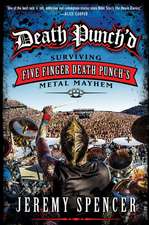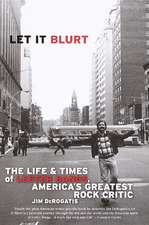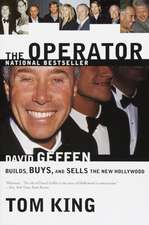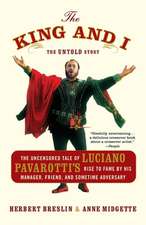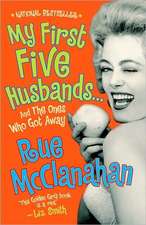Staring at Sound: The True Story of Oklahoma's Fabulous Flaming Lips
Autor Jim DeRogatisen Limba Engleză Paperback – 28 feb 2006
In July 2002, the Flaming Lips released an ambitious album called Yoshimi Battles the Pink Robots, which merged elements of orchestral pop, electronic dance music, and old-fashioned psychedelic rock with lyrical themes that were simultaneously poignant and philosophical and supremely silly. The album sold a million copies worldwide, introduced the Flaming Lips to a mass audience, and made them one of the best-known cult bands in rock history.
Staring at Sound is the tale of the Flaming Lips’s fascinating career (which, in reality, began in 1983) and the many colorful personalities in their orbit, especially Wayne Coyne, their charismatic and visionary founder. Based on hundreds of hours of interviews with the band, it follows the Flaming Lips through the thriving indie-rock underground of the 1980s and the alternative-rock movement of the early ’90s, during which they found fans in such rock legends as Paul McCartney, the Rolling Stones, Robert Plant, and Devo, and respected peers in such acts as the White Stripes, Radiohead, and Beck. It concludes with exclusive coverage of the creation of the group’s latest album, At War with the Mystics.
Preț: 112.64 lei
Nou
Puncte Express: 169
Preț estimativ în valută:
21.56€ • 23.43$ • 18.12£
21.56€ • 23.43$ • 18.12£
Carte tipărită la comandă
Livrare economică 21 aprilie-05 mai
Preluare comenzi: 021 569.72.76
Specificații
ISBN-13: 9780767921404
ISBN-10: 0767921402
Pagini: 251
Ilustrații: 15-20 B&W PHOTOGRAPHS
Dimensiuni: 160 x 227 x 18 mm
Greutate: 0.36 kg
Editura: BROADWAY BOOKS
ISBN-10: 0767921402
Pagini: 251
Ilustrații: 15-20 B&W PHOTOGRAPHS
Dimensiuni: 160 x 227 x 18 mm
Greutate: 0.36 kg
Editura: BROADWAY BOOKS
Notă biografică
Jim DeRogatis is the pop music critic at the Chicago Sun-Times. Together with Greg Kot, rock critic at the Chicago Tribune and author of Wilco: Learning How to Die, he is the host of Sound Opinions, “the world's only rock and roll talkshow,” which is now broadcast on Public Radio. He is the author of Let It Blurt: The Life and Times of Lester Bangs, America’s Greatest Rock Critic (Broadway Books, 2000), among other books.
Extras
Chapter 1
I Want My Own Planet
Frustrated by the lack of opportunity in southwestern Pennsylvania and drawn by the promise of a new job and a better life in Oklahoma–“Brand new state, gonna treat you great,” to quote the title tune of the Broadway musical, the official state song–Tom and Dolly Coyne loaded up the family car and set out on the seventeen-hour drive from Pittsburgh in the spring of 1961. Ranging in age from one to six, their four older children–Tommy, Kenny, Linda, and Marty–crammed into the backseat of the station wagon. Only a few months old, Dolly’s youngest son sat on her lap or perched on the dashboard, watching U.S. Route 66 unfold before them. “Maybe that is where I got my love of the highway,” Wayne joked forty-four years later.
Raised in working-class families of Scots-Irish, German, and Hungarian descent, Thomas Coyne and Dolores “Dolly” Jackson met and married in Pittsburgh’s Troy Hill neighborhood in the early fifties, and Dolly gave birth to their first son a short time later, at age seventeen. The family continued to grow after Tom returned from serving in Germany during the tail end of the Korean War. The couple’s fifth child, Wayne Michael Coyne, was born on January 13, 1961; their sixth and last, Wayne’s younger brother, Mark, arrived two years later, after the family had settled in its new home on the North Side of Oklahoma City.
Tom and Dolly both had watched their fathers work backbreaking jobs and die at relatively young ages. “My dad said that he didn’t want his kids growing up in the coal mines and steel mills of Pittsburgh, and that’s all there was in the fifties and sixties,” Tom’s son Marty said. “He wanted his kids to have a future, and he didn’t know what Oklahoma would bring, but he knew it would be better than Pittsburgh.” As is his style, Wayne put a more romantic spin on his parents’ decision to uproot their lives, leave their extended families, and move across the country: “They were going to go out and have this adventure.”
A skilled cabinet maker, Tom had been offered a position with an office supply company, but he arrived in Oklahoma City to find that the managerial position he’d been promised had been eliminated, and he wound up loading trucks. “He had given up everything for this dream,” Wayne said. “I always asked my mother, ‘Why didn’t you guys regroup and go back to Pittsburgh?’ If things don’t work out, so many people don’t have the courage to face up to it, but she said, ‘It sucked back there, too.’ The struggle wasn’t going to be any better anywhere else, so they stayed.”
Seventy years after the land run that attracted the “boomers” and “sooners” who settled the state, and two decades after the Dust Bowl migration of the Great Depression, Oklahoma City rapidly expanded in the late fifties, flush with money from the thriving oil industry. Between 1958 and 1961, its population increased by nearly a third, to four hundred thousand residents, according to the U.S. Census Bureau, but outside the capital, agriculture continued to form the backbone of the state’s economy, and rural attitudes and a striking homogeneity prevailed. According to the 1960 census, despite sizable populations of blacks and Native Americans, 90 percent of Oklahomans were white. Many were also poor–the median income traditionally is 75 percent of the national average–prompting a derisive nickname that lingers even today, when strip malls and office parks far outnumber family farms.
“Okie use’ta mean you was from Oklahoma,” an itinerant farmer says in John Steinbeck’s 1939 novel, The Grapes of Wrath. “Now it means you’re a dirty son-of-a-bitch. Okie means you’re scum. Don’t mean nothing itself, it’s the way they say it.”
As Roman Catholics, the Coyne family was a minority in what is often called “the Buckle of the Bible Belt.” To date, 77 percent of Oklahomans identify as conservative Christians, with the majority worshiping as Southern Baptists. The religious influence accounts for the fact that Oklahoma continued to ban liquor sales until 1959, a quarter-century after Prohibition ended in most of the country. State statutes still list blasphemy and failing to honor the Sabbath as misdemeanors, with penalties of one hundred dollars and twenty-five dollars per offense, respectively, though these are rarely enforced.
To a northerner who has made three week-long visits in the last decade, Oklahoma seems exotic only for its unrelentingly flat landscape and its pervasive blandness. It isn’t exactly nowhere, as one longtime resident told me; it’s just that it could be anywhere. There are strains of southern conservatism, midwestern tolerance, and the western frontier spirit, but none of the distinguishing eccentricities that characterize those regions. Residents can be suspect of new arrivals–“If you’re an outsider, you’re either a thief, someone else’s relative, or a bum,” another Oklahoman told me–but a strong work ethic is valued above everything besides God and family; the state motto, “Labor Omnia Vincit,” can be translated as “Work Conquers All.” Individual differences are tolerated with a quiet reserve, providing people work hard and keep to themselves, and the tight-knit Coyne family did exactly that.
“Because all of our relatives were in Pittsburgh, we didn’t have cousins and aunts and uncles, and we didn’t branch off into all these separate lives like a lot of families do,” Linda, the family’s only daughter, said. “We did everything together.” Life revolved around sports, family dinners, and big holiday celebrations, with Dolly as the warm, outgoing, and eternally upbeat cheerleader and organizer. “She was always optimistic and always curious,” Wayne said of his mom. “You never knew anything about her life, because she was always asking you, ‘Now, what is happening in your life?’”
Dolly not only doted on her own children and encouraged their diverse interests–Kenny’s running, Marty’s motorcycle racing, and Wayne’s drawing and painting–she became a mother figure for many of their friends. “Her house could never be too full, and Christmas celebrations and birthday parties regularly exceeded twenty-five to thirty people,” Wayne wrote in her obituary in July 2004. “She saw happiness as a situation one must create, not as something to be longed for.” To a greater degree than any of his siblings, he inherited this trait.
As reserved and determined as Dolly was gregarious and bubbly, Tom instilled in his children a respect for the virtues of hard work. “Coming from a family of six, if you wanted something, Santa wasn’t necessarily going to bring it,” his daughter, Linda, said. “When you were old enough, you went to work, doing paper routes or serving fast food at the Sonic. All of us always worked.” Her brother Marty agreed. “If you weren’t sweating your ass off, you weren’t working hard enough. Wayne said to me several times that Dad just thought that if you worked hard, everything would be all right in the end. That is not really the way it is, but that is how he lived his life.”
Unfailingly loyal to family, friends, and coworkers, Tom believed that a man’s word was his bond, and he trusted people to behave as ethically as he did, but nine years after the family arrived in Oklahoma, his faith was shaken when he became the subject of a scandal that made front-page news in the Daily Oklahoman. Through his unrelenting labors, Tom had moved from the loading docks to become president of the Fields—Down Randolph office supply company when, on January 30, 1970, he was arrested by the FBI for embezzlement. The federal complaint alleged that he had conspired with Roy Meier, an assistant cashier and purchasing agent for the Oklahoma City Bank, to steal $1,660.50, a sum worth roughly four and a half times that amount in 2005 dollars.
The FBI claimed that Tom had submitted a phony invoice for bank deposit envelopes to Meier, who authorized the payment, then split the money with his alleged co-conspirator. Tom maintained his innocence, but Meier, who had been the target of the investigation, pleaded guilty to misappropriating seventy-five thousand dollars during a six-year period, and he agreed to testify for the prosecution against Tom. The trial began in June 1970, when Wayne was nine. The school year had just ended, and the defendant’s six children sat in the front row of the courtroom throughout the proceedings.
“Things will be in the newspaper, but they’re all wrong: I didn’t do it, and we are going to get through this,” Tom told his family. His daughter, Linda, recalled his attorney arranging them in a line from oldest to youngest. “We didn’t really know what the trial was all about, we just knew our dad was in trouble,” she said. When neighboring kids taunted that their father was going to jail, the Coyne children had a ready response: “No, he’s not, because he said he’s not.” For Tom, the betrayal of a trusted customer was as hurtful as being falsely accused of a crime. According to a report in the Daily Oklahoman, the thirty-six-year-old father of six sat brooding as Meier testified about their alleged fraud. The jury didn’t believe Meier, and after four days, Tom was acquitted. But he paid a price.
“Our family changed through that,” Linda said. “Our mom had to go to work, and our dad lost his job, which really rubbed him raw–he had been so devoted to that company. Up until then, he would go golfing with these guys he worked with; they had breakfast every Friday or Sunday, they would go bowling, and he belonged to all these groups. Once all that happened, he didn’t do any of that anymore.”
“I guess I was just so young and life was so good that it never dawned on me that he could go to jail,” Wayne said of his father’s ordeal. “I never felt like you could see a change in him the way Kenny and Linda talked about it. They said that before then, my mother and father were of the same [optimistic] ilk–the sunny day and the sunny day–and after that, it turned. She became even more resilient–like, ‘Look, we know bad things happen all the time, but life is still good’–and he became very much like, ‘Fuck ’em.’ But it wasn’t something that a nine-year-old could see.” Nevertheless, an abiding respect for loyalty and a devotion to honesty were two more traits that Wayne would inherit from his parents and carry into later life.
Shortly before Wayne started his freshman year in high school, the Coyne family moved from the North Side to a slightly larger, though still overcrowded, four-bedroom house with tan aluminum siding near NW Twelfth Street and N. Klein Avenue, one of a row of single-family homes in Oklahoma City’s Classen-Ten-Penn neighborhood. In the years since, Wayne has often called the area “the ghetto,” though he notes, “It’s really lower-middle-class interspersed with desperate people. The truth about all ghettoes is there’s always a mix of people who are trying to work and people who don’t work and do illegal things or whatever. I say ‘ghetto’ just because in Oklahoma City, it’s one of the worst areas.”
Classen High School was one of the two oldest and poorest schools in the city, and it ranked among the least academically distinguished, with a faculty that cared more about coaching football than teaching class, and who viewed the Classen Comets as the only viable path for students who wanted to go to college. (“The law requires every citizen to be vitally interested in football,” The New Yorker wrote in a brief profile of the team in December 1983. “Have your car safety-inspected, be home by nine-thirty, always know the score–those are the rules.”) While enrollment was declining in the mid-seventies, the number of minority students was rising– about a third were African-American, and another third came from Oklahoma’s growing population of immigrants from Cambodia, Vietnam, and Laos–and amid considerable controversy, city officials would close the school in the mid-eighties. When Wayne arrived in 1975, he found little to motivate him.
“We had come from the schools on the North Side, which at the time were the bigger and better schools in town, and we were used to things being a little more accelerated. I think if I had stayed in school on the North Side, I would have done better, but here, they were working at such a lower level that you could just zip through. I had some teachers who were really great–there was the occasional English teacher who’d really see when people had a curiosity about them–but the art teachers were for the most part a waste of time. I was like, ‘I can do this work in five minutes. I can do better on my own.’”
The Coynes had already pegged Wayne as the artist in their midst, and in his early teens, he sometimes earned money by drawing pictures of the children of his father’s coworkers. The siblings could tease each other about their ambitions, but ultimately they supported one another’s dreams. “By the time I got into the picture, it was like Tarzan being raised by the apes,” Wayne said. “We all did weird things–somebody was going to join the Hell’s Angels, and somebody else wanted to be Evel Knievel–but they allowed me to do whatever I wanted without being beat up, which is a big deal when you are younger. Everyone thought I’d be an artist, and when you can view the possibilities, you think, ‘Well, I guess I really could do that. Maybe I could be an artist.’”
Wayne could often be found sitting alone for hours, drawing or painting pictures in the bedroom he shared with his younger brother, Mark. Occasionally he worked on the dining-room table beside Tommy, six years his elder and a skillful artist himself, sketching comic-book heroes such as the Silver Surfer and the Hulk. At first Wayne tried to imitate his older brother. “I was still a really little kid, and I remember that I got stuck once on a picture and asked Tommy to help me,” he said. Tommy refused and told his younger brother to do it on his own. “So I went ahead and did the drawing and found out that I was able to do it by myself. I came to see that whether it was with writing, drawing, or playing guitar, if you could remove yourself from all this exciting shit that was going on around you, and sit there by yourself and focus, you could figure things out on your own.”
I Want My Own Planet
Frustrated by the lack of opportunity in southwestern Pennsylvania and drawn by the promise of a new job and a better life in Oklahoma–“Brand new state, gonna treat you great,” to quote the title tune of the Broadway musical, the official state song–Tom and Dolly Coyne loaded up the family car and set out on the seventeen-hour drive from Pittsburgh in the spring of 1961. Ranging in age from one to six, their four older children–Tommy, Kenny, Linda, and Marty–crammed into the backseat of the station wagon. Only a few months old, Dolly’s youngest son sat on her lap or perched on the dashboard, watching U.S. Route 66 unfold before them. “Maybe that is where I got my love of the highway,” Wayne joked forty-four years later.
Raised in working-class families of Scots-Irish, German, and Hungarian descent, Thomas Coyne and Dolores “Dolly” Jackson met and married in Pittsburgh’s Troy Hill neighborhood in the early fifties, and Dolly gave birth to their first son a short time later, at age seventeen. The family continued to grow after Tom returned from serving in Germany during the tail end of the Korean War. The couple’s fifth child, Wayne Michael Coyne, was born on January 13, 1961; their sixth and last, Wayne’s younger brother, Mark, arrived two years later, after the family had settled in its new home on the North Side of Oklahoma City.
Tom and Dolly both had watched their fathers work backbreaking jobs and die at relatively young ages. “My dad said that he didn’t want his kids growing up in the coal mines and steel mills of Pittsburgh, and that’s all there was in the fifties and sixties,” Tom’s son Marty said. “He wanted his kids to have a future, and he didn’t know what Oklahoma would bring, but he knew it would be better than Pittsburgh.” As is his style, Wayne put a more romantic spin on his parents’ decision to uproot their lives, leave their extended families, and move across the country: “They were going to go out and have this adventure.”
A skilled cabinet maker, Tom had been offered a position with an office supply company, but he arrived in Oklahoma City to find that the managerial position he’d been promised had been eliminated, and he wound up loading trucks. “He had given up everything for this dream,” Wayne said. “I always asked my mother, ‘Why didn’t you guys regroup and go back to Pittsburgh?’ If things don’t work out, so many people don’t have the courage to face up to it, but she said, ‘It sucked back there, too.’ The struggle wasn’t going to be any better anywhere else, so they stayed.”
Seventy years after the land run that attracted the “boomers” and “sooners” who settled the state, and two decades after the Dust Bowl migration of the Great Depression, Oklahoma City rapidly expanded in the late fifties, flush with money from the thriving oil industry. Between 1958 and 1961, its population increased by nearly a third, to four hundred thousand residents, according to the U.S. Census Bureau, but outside the capital, agriculture continued to form the backbone of the state’s economy, and rural attitudes and a striking homogeneity prevailed. According to the 1960 census, despite sizable populations of blacks and Native Americans, 90 percent of Oklahomans were white. Many were also poor–the median income traditionally is 75 percent of the national average–prompting a derisive nickname that lingers even today, when strip malls and office parks far outnumber family farms.
“Okie use’ta mean you was from Oklahoma,” an itinerant farmer says in John Steinbeck’s 1939 novel, The Grapes of Wrath. “Now it means you’re a dirty son-of-a-bitch. Okie means you’re scum. Don’t mean nothing itself, it’s the way they say it.”
As Roman Catholics, the Coyne family was a minority in what is often called “the Buckle of the Bible Belt.” To date, 77 percent of Oklahomans identify as conservative Christians, with the majority worshiping as Southern Baptists. The religious influence accounts for the fact that Oklahoma continued to ban liquor sales until 1959, a quarter-century after Prohibition ended in most of the country. State statutes still list blasphemy and failing to honor the Sabbath as misdemeanors, with penalties of one hundred dollars and twenty-five dollars per offense, respectively, though these are rarely enforced.
To a northerner who has made three week-long visits in the last decade, Oklahoma seems exotic only for its unrelentingly flat landscape and its pervasive blandness. It isn’t exactly nowhere, as one longtime resident told me; it’s just that it could be anywhere. There are strains of southern conservatism, midwestern tolerance, and the western frontier spirit, but none of the distinguishing eccentricities that characterize those regions. Residents can be suspect of new arrivals–“If you’re an outsider, you’re either a thief, someone else’s relative, or a bum,” another Oklahoman told me–but a strong work ethic is valued above everything besides God and family; the state motto, “Labor Omnia Vincit,” can be translated as “Work Conquers All.” Individual differences are tolerated with a quiet reserve, providing people work hard and keep to themselves, and the tight-knit Coyne family did exactly that.
“Because all of our relatives were in Pittsburgh, we didn’t have cousins and aunts and uncles, and we didn’t branch off into all these separate lives like a lot of families do,” Linda, the family’s only daughter, said. “We did everything together.” Life revolved around sports, family dinners, and big holiday celebrations, with Dolly as the warm, outgoing, and eternally upbeat cheerleader and organizer. “She was always optimistic and always curious,” Wayne said of his mom. “You never knew anything about her life, because she was always asking you, ‘Now, what is happening in your life?’”
Dolly not only doted on her own children and encouraged their diverse interests–Kenny’s running, Marty’s motorcycle racing, and Wayne’s drawing and painting–she became a mother figure for many of their friends. “Her house could never be too full, and Christmas celebrations and birthday parties regularly exceeded twenty-five to thirty people,” Wayne wrote in her obituary in July 2004. “She saw happiness as a situation one must create, not as something to be longed for.” To a greater degree than any of his siblings, he inherited this trait.
As reserved and determined as Dolly was gregarious and bubbly, Tom instilled in his children a respect for the virtues of hard work. “Coming from a family of six, if you wanted something, Santa wasn’t necessarily going to bring it,” his daughter, Linda, said. “When you were old enough, you went to work, doing paper routes or serving fast food at the Sonic. All of us always worked.” Her brother Marty agreed. “If you weren’t sweating your ass off, you weren’t working hard enough. Wayne said to me several times that Dad just thought that if you worked hard, everything would be all right in the end. That is not really the way it is, but that is how he lived his life.”
Unfailingly loyal to family, friends, and coworkers, Tom believed that a man’s word was his bond, and he trusted people to behave as ethically as he did, but nine years after the family arrived in Oklahoma, his faith was shaken when he became the subject of a scandal that made front-page news in the Daily Oklahoman. Through his unrelenting labors, Tom had moved from the loading docks to become president of the Fields—Down Randolph office supply company when, on January 30, 1970, he was arrested by the FBI for embezzlement. The federal complaint alleged that he had conspired with Roy Meier, an assistant cashier and purchasing agent for the Oklahoma City Bank, to steal $1,660.50, a sum worth roughly four and a half times that amount in 2005 dollars.
The FBI claimed that Tom had submitted a phony invoice for bank deposit envelopes to Meier, who authorized the payment, then split the money with his alleged co-conspirator. Tom maintained his innocence, but Meier, who had been the target of the investigation, pleaded guilty to misappropriating seventy-five thousand dollars during a six-year period, and he agreed to testify for the prosecution against Tom. The trial began in June 1970, when Wayne was nine. The school year had just ended, and the defendant’s six children sat in the front row of the courtroom throughout the proceedings.
“Things will be in the newspaper, but they’re all wrong: I didn’t do it, and we are going to get through this,” Tom told his family. His daughter, Linda, recalled his attorney arranging them in a line from oldest to youngest. “We didn’t really know what the trial was all about, we just knew our dad was in trouble,” she said. When neighboring kids taunted that their father was going to jail, the Coyne children had a ready response: “No, he’s not, because he said he’s not.” For Tom, the betrayal of a trusted customer was as hurtful as being falsely accused of a crime. According to a report in the Daily Oklahoman, the thirty-six-year-old father of six sat brooding as Meier testified about their alleged fraud. The jury didn’t believe Meier, and after four days, Tom was acquitted. But he paid a price.
“Our family changed through that,” Linda said. “Our mom had to go to work, and our dad lost his job, which really rubbed him raw–he had been so devoted to that company. Up until then, he would go golfing with these guys he worked with; they had breakfast every Friday or Sunday, they would go bowling, and he belonged to all these groups. Once all that happened, he didn’t do any of that anymore.”
“I guess I was just so young and life was so good that it never dawned on me that he could go to jail,” Wayne said of his father’s ordeal. “I never felt like you could see a change in him the way Kenny and Linda talked about it. They said that before then, my mother and father were of the same [optimistic] ilk–the sunny day and the sunny day–and after that, it turned. She became even more resilient–like, ‘Look, we know bad things happen all the time, but life is still good’–and he became very much like, ‘Fuck ’em.’ But it wasn’t something that a nine-year-old could see.” Nevertheless, an abiding respect for loyalty and a devotion to honesty were two more traits that Wayne would inherit from his parents and carry into later life.
Shortly before Wayne started his freshman year in high school, the Coyne family moved from the North Side to a slightly larger, though still overcrowded, four-bedroom house with tan aluminum siding near NW Twelfth Street and N. Klein Avenue, one of a row of single-family homes in Oklahoma City’s Classen-Ten-Penn neighborhood. In the years since, Wayne has often called the area “the ghetto,” though he notes, “It’s really lower-middle-class interspersed with desperate people. The truth about all ghettoes is there’s always a mix of people who are trying to work and people who don’t work and do illegal things or whatever. I say ‘ghetto’ just because in Oklahoma City, it’s one of the worst areas.”
Classen High School was one of the two oldest and poorest schools in the city, and it ranked among the least academically distinguished, with a faculty that cared more about coaching football than teaching class, and who viewed the Classen Comets as the only viable path for students who wanted to go to college. (“The law requires every citizen to be vitally interested in football,” The New Yorker wrote in a brief profile of the team in December 1983. “Have your car safety-inspected, be home by nine-thirty, always know the score–those are the rules.”) While enrollment was declining in the mid-seventies, the number of minority students was rising– about a third were African-American, and another third came from Oklahoma’s growing population of immigrants from Cambodia, Vietnam, and Laos–and amid considerable controversy, city officials would close the school in the mid-eighties. When Wayne arrived in 1975, he found little to motivate him.
“We had come from the schools on the North Side, which at the time were the bigger and better schools in town, and we were used to things being a little more accelerated. I think if I had stayed in school on the North Side, I would have done better, but here, they were working at such a lower level that you could just zip through. I had some teachers who were really great–there was the occasional English teacher who’d really see when people had a curiosity about them–but the art teachers were for the most part a waste of time. I was like, ‘I can do this work in five minutes. I can do better on my own.’”
The Coynes had already pegged Wayne as the artist in their midst, and in his early teens, he sometimes earned money by drawing pictures of the children of his father’s coworkers. The siblings could tease each other about their ambitions, but ultimately they supported one another’s dreams. “By the time I got into the picture, it was like Tarzan being raised by the apes,” Wayne said. “We all did weird things–somebody was going to join the Hell’s Angels, and somebody else wanted to be Evel Knievel–but they allowed me to do whatever I wanted without being beat up, which is a big deal when you are younger. Everyone thought I’d be an artist, and when you can view the possibilities, you think, ‘Well, I guess I really could do that. Maybe I could be an artist.’”
Wayne could often be found sitting alone for hours, drawing or painting pictures in the bedroom he shared with his younger brother, Mark. Occasionally he worked on the dining-room table beside Tommy, six years his elder and a skillful artist himself, sketching comic-book heroes such as the Silver Surfer and the Hulk. At first Wayne tried to imitate his older brother. “I was still a really little kid, and I remember that I got stuck once on a picture and asked Tommy to help me,” he said. Tommy refused and told his younger brother to do it on his own. “So I went ahead and did the drawing and found out that I was able to do it by myself. I came to see that whether it was with writing, drawing, or playing guitar, if you could remove yourself from all this exciting shit that was going on around you, and sit there by yourself and focus, you could figure things out on your own.”
Recenzii
Praise for Let It Blurt
“A personal journey through the wit and the world and the ferocious spirit of Lester Bangs.…It reads like rock and roll.” —Cameron Crowe
“Let It Blurt tells one of the essential rock and roll stories with great affection and panache. Lester Bangs—paradigm, mystery, great writer, tragicomic presence—has been given the biography he deserves.…A splendid book.” —Jonathan Lethem
“A personal journey through the wit and the world and the ferocious spirit of Lester Bangs.…It reads like rock and roll.” —Cameron Crowe
“Let It Blurt tells one of the essential rock and roll stories with great affection and panache. Lester Bangs—paradigm, mystery, great writer, tragicomic presence—has been given the biography he deserves.…A splendid book.” —Jonathan Lethem
Descriere
This work follows the Lips through the thriving indie-rock underground of the 1980s and the alternative rock movement of the early '90s, during which they found fans in such rock legends as Paul McCartney, the Rolling Stones, and Robert Plant.

